|
George Palmer Lumber Company |
|
|
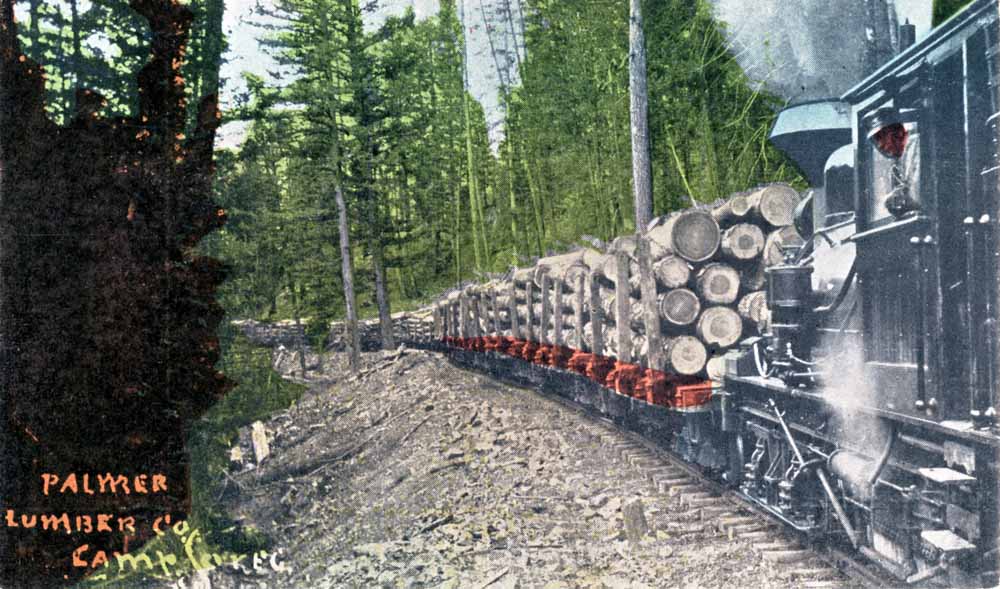 |
|
Colorized postcard from 1910 of a George Palmer log train. Jeff Moore collection.
|
|
|
|
History George Palmer first got into the lumber business in the Chicago wholesale markets. After spending several decades in the upper midwest Palmer started moving west, first to Iowa, and then in 1902 to northeastern Oregon. Palmer first settled in Elgin, where he along with his nephew Vincent Palmer brokered lumber produced by several small mills. Palmer then organized the George Palmer Lumber Company in 1904, which constructed a large sawmill in La Grande in 1907. The company used logging railroads from the start, as a June 1907 news report in an industry publication indicated Palmer had two miles of completed logging railroad and a 45-ton Shay locomotive in use. The Palmer company grew fast, as evidenced by an article on the company's operations carried in the American Lumberman edition of 27 May 1911, reproduced here from Barton Jennings Oregon's Joseph Branch book: "This is where the famous "Looking Glass Pine" is manufactured. This product, the name of which has come to denote quality, takes its name from Looking Glass creek, a mountain stream flowing through the company's holdings, thirty-five miles north of La Grande, on the Elgin branch of the Oregon & Washington Railroad & Navigation railroad. Here, at Palmer Junction, the company's logging road connects and runs out into the timber with twenty miles of main line and numerous branches. A glance at the equipment of these camps will show the extent of the operations. This equipment consists of one 70- and one 45- ton Shay locomotive, two 4-line Clyde steam skidders, two McGiffert steam loaders, four donkey engines, machine shop, blacksmith shops, pumping station, water tank cars for supplying water to machines and fighting fires, thirty head of horses, and fifty 41-foot steel log cars equipped with stakes and Eau Claire safety trip pockets." The Palmer railroad apparently operated two directions from Palmer Junction, one line up Looking Glass and then Little Looking Glass creeks and the other line up Schotte Creek (now Moses Creek) into the Palmer Valley, named after the company. Palmer operated at least three logging camps, one on Looking Glass creek and the other two in the valley. Ed Gettings, an engineer on the Palmer railroad, later wrote the following about some of his experiences on the operation. I went to Palmer Valley in May 1910, as an engineer on the Shay engine that brought the logs from the various camps to the main line. The roads were hastily built and temporary. The grades ran from 3 to as high as 10 percent. Our road down Shoddy (sic) Creek to the Junction had some 7 percent grade. The operation had started in 1908, and I finished in March 1914. In one month I hauled 5,000,000 feet of logs out of the valley. The daily average would be about 15 carloads, each car hauling about 10,000 feet. In all, some 270,000,000 feet must have gone out of the valley. It was nearly all yellow pine and good quality. The steep and extremely crooked grade down Shoddy Creek had a bad reputation. A train could easily go out of control on such a steep grade. After taking four cars down for a few trips, I figured out a system that I was sure would work. When I asked for the entire day's output, which was 21 cars, on the next trip the boss was hard to convince. He was afraid that his train would be piled up in the bottom of the canyon. At last he gave in to my persistance. A combination of manipulation, my air brakes and using the sharp curves to bind my cars, I made it down better than with the four cars. Four cars did not make long enough a train to wedge against the wheel flanges on the curves. This wedging was more effective than brakes. After that I continued to take full trains down and never had trouble." 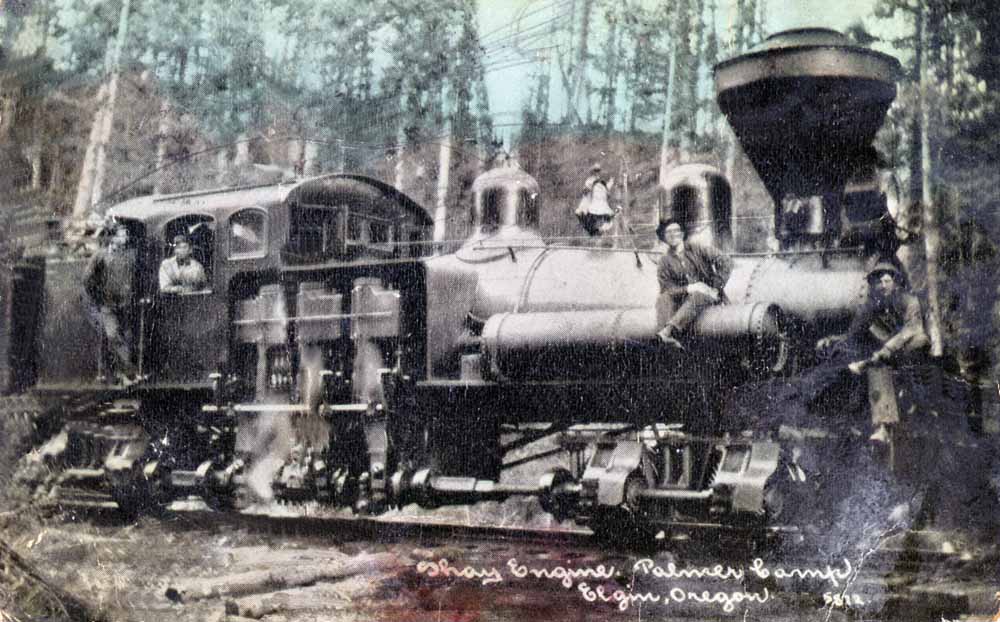 An early postcard view of a George Palmer Lumber Shay and its crew. Another report in the October 1912 issue of The Timberman reported the following on the operation, which included some references to a fourth camp being established and an apparent expansion up the Looking Glass/Little Looking Glass creeks: "At this point the Geo. Palmer Lumber Co's logging road connects with the Elgin branch. Standard steel flats and an 80-ton Shay bring the loads from the woods to the Junction, where they are transported to La Grande, a distance of 33 miles, while another Shay assembles the loads. Four Willamettes and a Washington Iron Works doneky, two Clyde Iron Works skidders and two CLyde loaders consistute the steam equipment, in addition to the teams. At the present time over 150,000 feet is going out daily. The company just completed new portable camps at Looking Glass; one building is 54 feet and the other 96 feet, each 16 feet wide. These camps are built in multiples of 16 feet and can be quickly placed on cars. The company say they find the steel logging flat the most serviceable car they have yet been able to use in the woods. They are practically unbreakable and carry very heavy loads. The company are just opening up a new camp at Looking Glass, which will be known as Camp No. 4. A dam will be thrown across the Looking Glass and the logs loaded on the cars with a Clyde loader." Due to the topography of the region most of the logging along Looking Glass Creek occurred on the ridgelines a full 600 feet above the logging railroad running up the drainage bottoms. The company used chutesto drop logs down to the railroad, which caused the operation to start using a small gasoline powered donkey drum to control the speed of logs on the chute. The George Palmer company pretty quickly cut through their holdings on Looking Glass Creek. The company then turned its attention to its holdings in Wallowa County, and around 1912 Palmer contracted with Morrison-Knudsen to build a logging railroad from Vincent, named after Vincent Palmer, up Howard Creek to reach the company's timberlands. Another news report in late 1913 recorded rails had been laid for several miles on the new road, with construction anticipated to be completed in 1914 in plenty of time for harvesting to commence before the timber in the Looking Glass area ran out. The railroad proved to be a challenging construction job, requiring a lot of blasting and other earth work, and according to several sources the Palmer company never was able to fully recover its investment in the road. Palmer established its Camp 5 near the top of Howard Creek, which included a 4-stall engine house, and operations shifted entirely to this line in 1914. The Grande Ronde Lumber Company later used part of the old Palmer railroad up Looking Glass Creek for its logging railroad. The George Palmer Lumber Company over most of the following decade pushed a network of logging railroads out into the woods north and east from the camp. Somewhere in this time frame the Palmer company built another logging railroad off of the Joseph Branch at Rondowa that ran at least a couple miles up the Grande Ronde river. The company prospered through the rest of the 1910s and into the early 1920s. Ill health forced both George and Vincent Palmer retired from the company in 1921, and then George Palmer died suddenly on 11 July 1922. The remaining stockholders subsequently sold the company to the Bowman-Hicks Lumber Company, and the subsequent operations are covered in that section of this site. |
|
|
Maps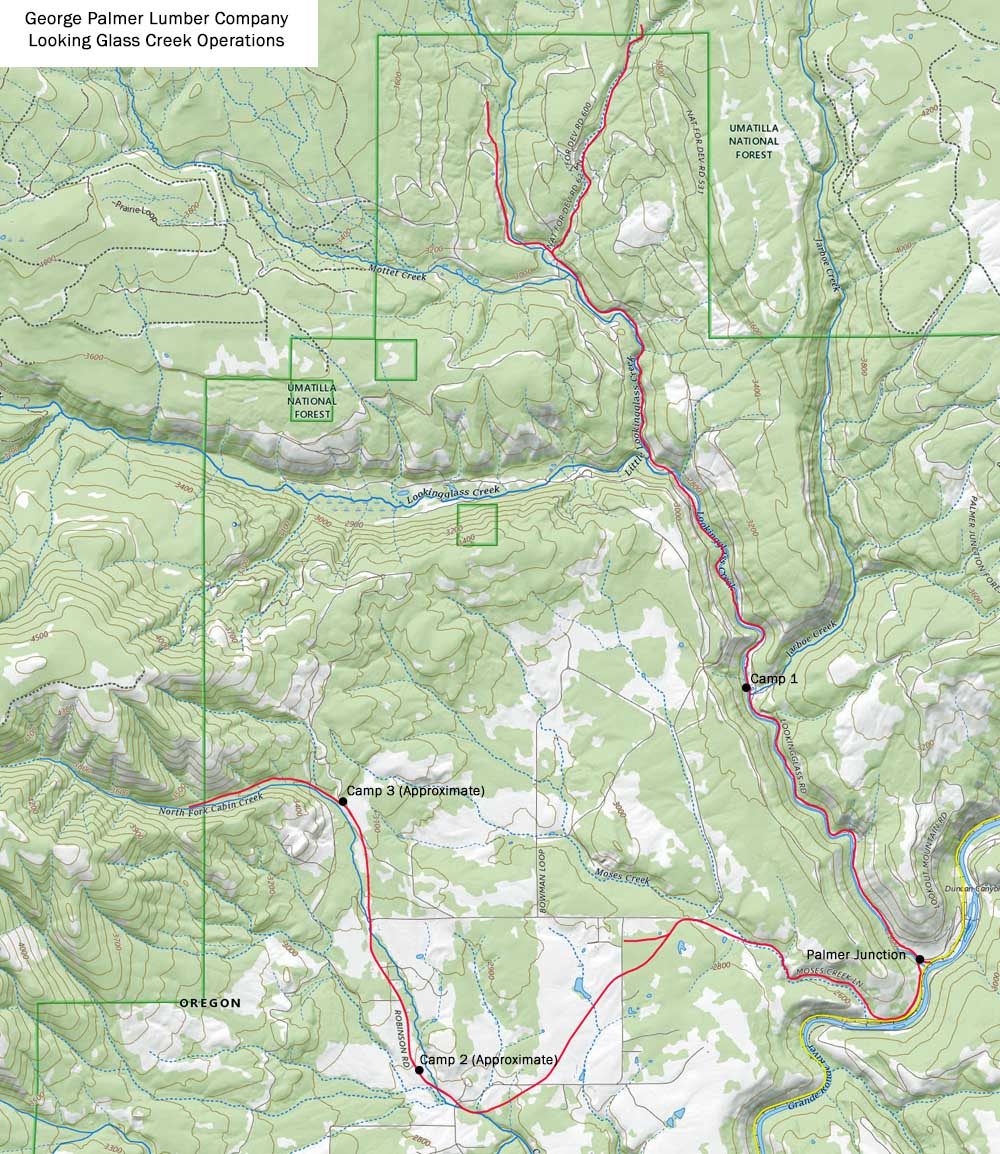 |
|
Rough and very speculative map of the George Palmer logging railroad in the Looking Glass creek area. No surviving historical maps are known to exist, and logging railroads
are based on a few narrative descriptions, some speculative interpretation of available Lidar imagery, and a hand drawn map showing approximate locations of Camps 2 and 3.
|
 |
|
Rough map of the George Palmer logging railroad in the Rondowa and Howard Creek/Camp 5 areas.
|
|
|
|
Locomotive Roster
1- Lima 2-Truck Shay, c/n 1894, Built 3/15/1907. 45 Tons. Purchased new through Hofius Steel & Equipment Company; to Bowman-Hicks Lumber Company #1. For sale by 1934 and scrapped sometime shortly afterwards. 2- Lima 3-Truck Shay, c/n 2144, Built 4/3/1909. 70 Tons. Purchased new through Hofius Steel & Equipment Company; to Bowman-Hicks Lumber Company #2; to Alaska Junk Company, Portland, Oregon; Scrapped 1/1940. 3- Lima 3-Truck Shay, c/n 2845, Built 11/24/1916. 100 Tons. Purchased new through Hofius Steel & Equipment Company; to Bowman-Hicks Lumber Company #3; to Kosmos Logging Company #3, Kosmos, WA; to Kosmos Timber Company #3, Kosmos, WA; to U.S. Plywood Corp #3, Kosmos, WA. 4- Lima 3-Truck Shay, c/n 3008, Built 8/27/1918. Built as Spruce Production Corporation (U.S. Army)#700, Siemscarey, WA; Assigned to Siems, Carey-H.S. Kerbaugh Corp. (Clallam County Railroad), Siemscarey, WA; to Vancouver Barracks for sale 12/1918; to George Palmer Lumber Company #4 6/30/1919; to Bowman-Hicks #4; to Alaska Junk Company, Portland, OR. Scrapped, with boiler sold to L.H.L. Lumber Company, Carlton, Oregon. |
|
|
|
Photos |
 |
|
A colorized postcard of the George Palmer mill in La Grande. Jeff Moore collection.
|
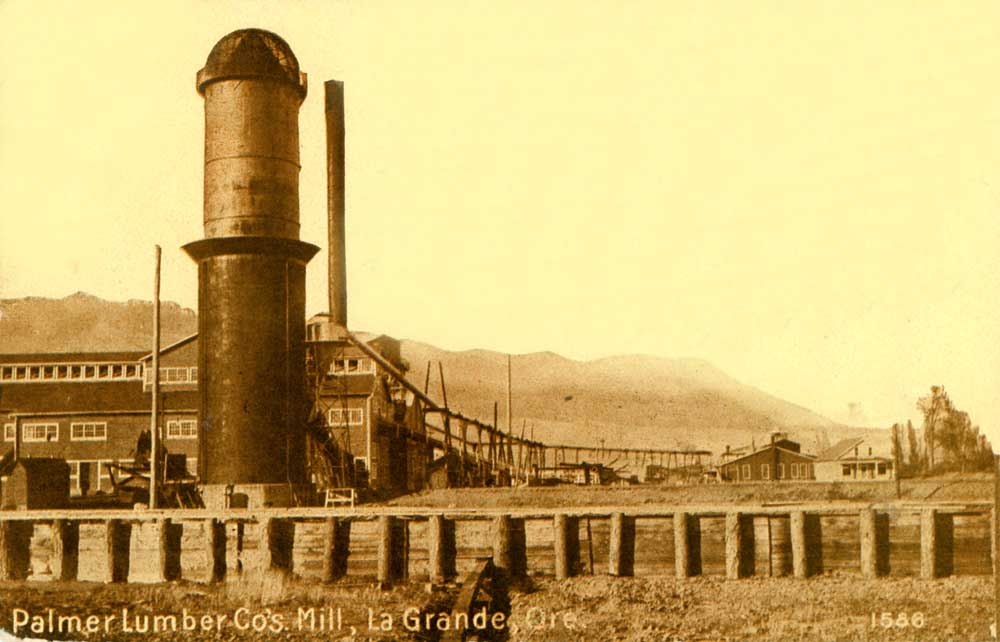 |
|
Another view of the George Palmer mill, this one taken looking across the front of the mill. Jeff Moore collection.
|
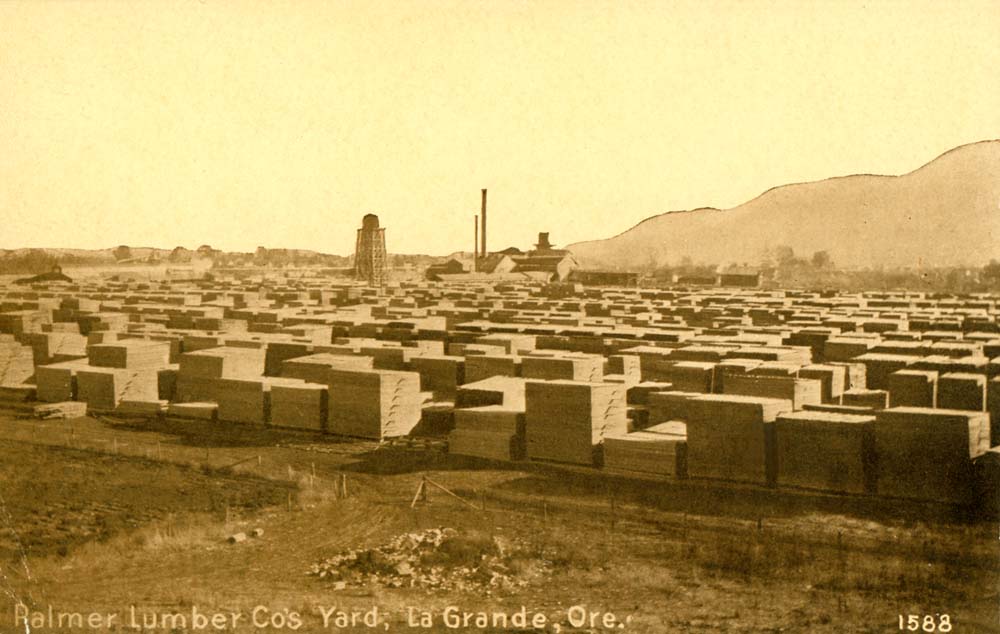 |
|
The George Palmer Lumber Company lumber yards in La Grande. Jeff Moore collection.
|
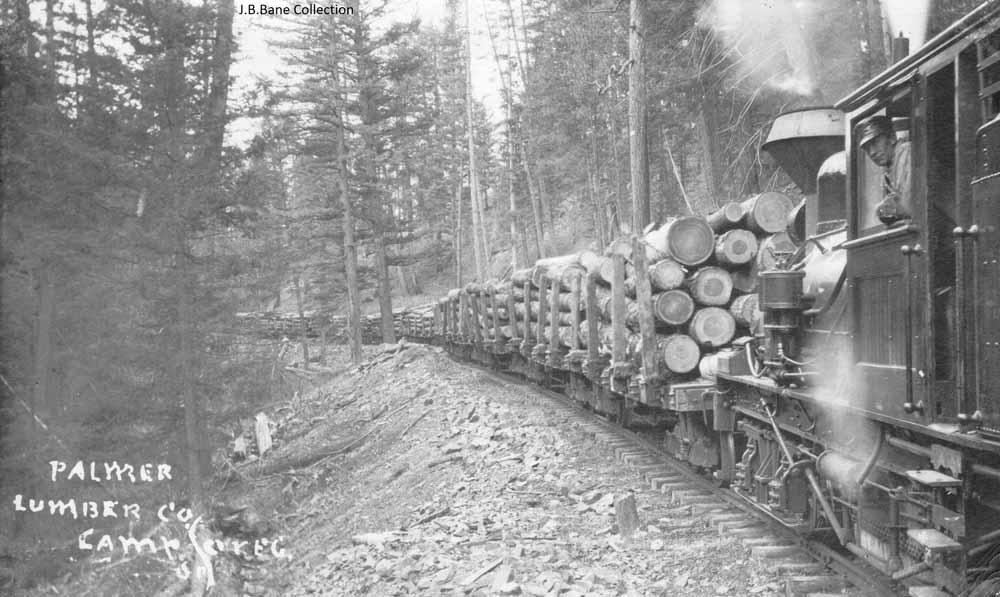 |
|
Original version of the image at the top of the page. J.B. Bane collection.
|
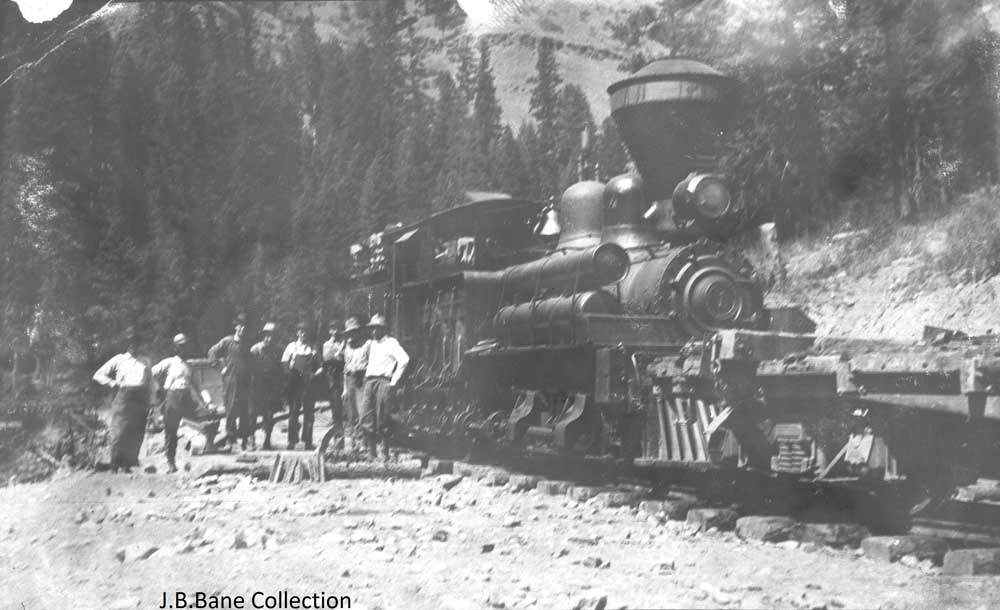 |
|
George Palmer Lumber Company Shay #1 with its crew. J.B. Bane collection.
|
 |
|
George Palmer Lumber Company Shay #2 with its crew. J.B. Bane collection.
|
 |
|
One of George Palmer's two McGiffert loaders at work. J.B. Bane collection.
|
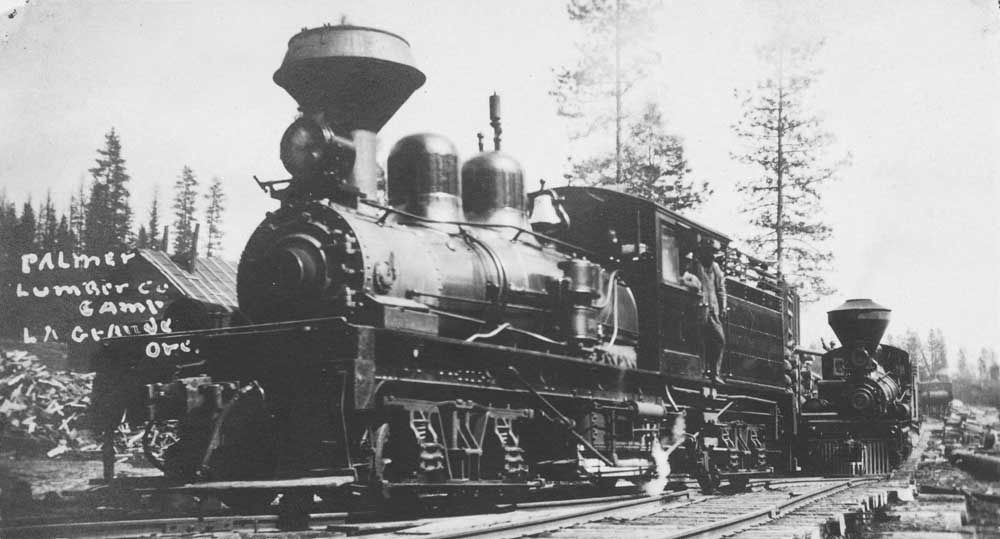 |
|
Palmer Shays 1 and 2 together at a camp. J.B. Bane collection.
|
 |
|
A Palmer log train arriving at the Union Pacific connection at Rondowa. J.B. Bane collection.
|
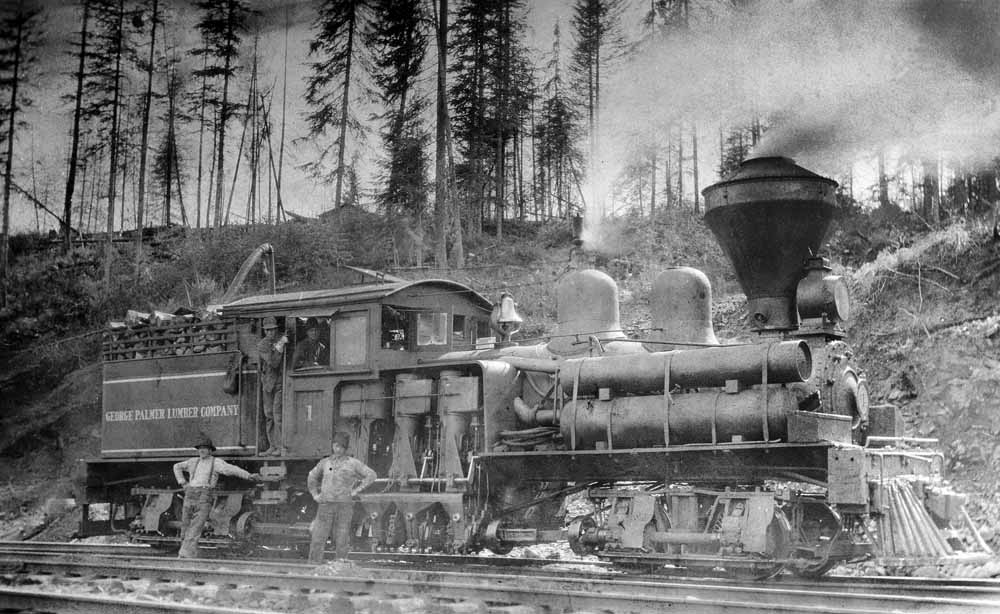 |
|
An undated photo of the Palmer Lumber #1. Photo location is stated as Lostine, which is near Wallowa, which indicates it may date from after Bowman-Hicks bought the company.
Jeff Moore collection.
|
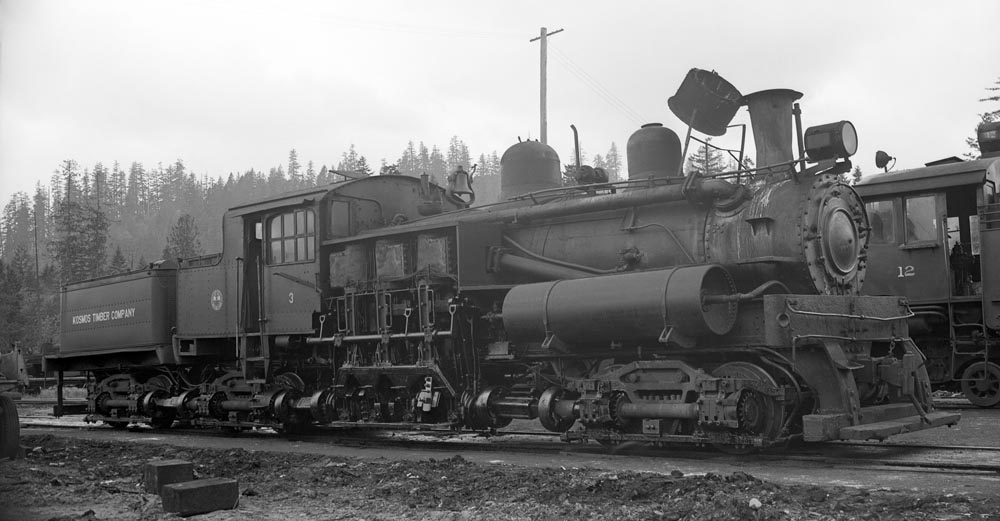 |
|
Kosmos Timber #3, formerly George Palmer Lumber #3, at Kosmos, Washington, on 12 May 1952. Jeff Moore collection.
|
 |
|
Some of the concrete foundations of the large shop Palmer built at Camp 5 at the top of Howard Creek. J.B. Bane photo.
|
 |
|
Remnants of a trestle near Camp 5. J.B. Bane photo.
|
|
|